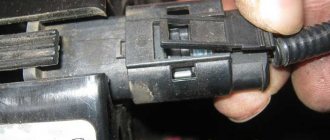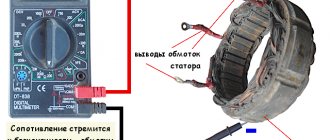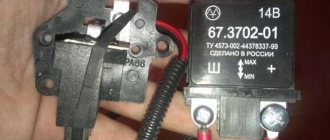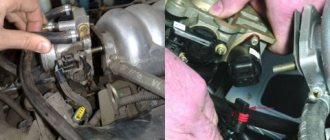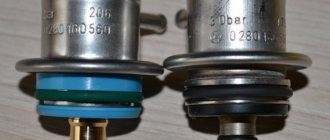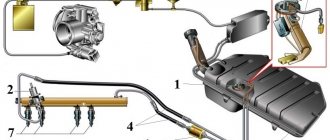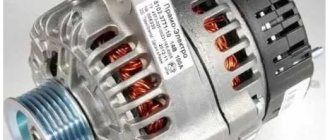May 21, 2020 Lada.Online 43 793 13
One of the popular modifications among LADA car owners is the installation of a remote three-level voltage regulator (TRV). We'll tell you about its purpose and how to install it yourself.
Three-level voltage regulator for VAZ-2110
The main provocateur for the rapid failure of batteries is the frequent change of operating modes and little depends on the driver of the vehicle.
The battery, in turn, requires different voltages to charge. To solve this problem, a regulator comes to the rescue. The standard device installed by default does not cope well with its responsibilities, because the circuit uses a very simple design that supplies only constant voltage. The disadvantage of such a regulator is that it does not take into account the speed of the vehicle, the amount of energy required and the ambient temperature.
A three-level voltage regulator can optimize all these processes.
Standard regulator diagram
The usual voltage regulator circuit provides diodes of different levels. However, their barriers may differ significantly. This is primarily due to a sharp change in voltage in the system. The current should also be taken into account. Among other things, the regulators have radiators.
Their main task is to cool the diodes. The position of the device is directly controlled using a toggle switch. The voltage regulator circuit also contains an electric drive strip, which closes the circuit.
Regulator connection process
Next, unscrew the generator nut using the appropriate wrench. To gain access to the casing, the block is removed, which is usually secured with three latches. To disconnect, you need to slightly pry the block from the edge. Next, the casing should be easy to remove.
The next step is to unscrew the screws, but first make sure that the plug is completely removed. Next, the nut is removed, the ends of which should be well processed with a file. This is necessary in order to improve the contact of the diode bridge with the bushing. The brush holder is mounted in place of the regulator. It is important to take care of its seal during installation in order to fix the device more securely.
The next step is to reinstall the plastic casing in its place and you can begin laying the regulator wire. Do everything carefully and take into account the placement of the main wiring of the machine.
To prevent the wires from dangling, secure them with plastic clamps.
Only after all the above steps are completed, the device itself is installed. Contact with ground must be reliable. Often, a shunt is used for this, which makes it possible to fasten the regulator and generator housings much better.
Once the device has been connected, you need to screw in the other wires from the kit. Upon completion of all installation work, the functionality of the device should be checked. It is important to load the battery to full - turn on the stove, radio, headlights, and so on.
Regulator characteristics
Depending on their type, devices can be manufactured in portable or stationary versions. They can be installed in any position: vertical, ceiling, horizontal.
The main characteristics of the devices include the following parameters:
- Smooth adjustment. Indicates the minimum step with which the potential difference at the output changes. The smoother it is, the more accurately you can set the output voltage value.
- Operating power. It is characterized by the value of current that can pass through the device for a long time without damaging its electronic connections.
- Maximum power. The peak value that a device can withstand for a short time while maintaining its functionality.
- Input voltage range. These are the input signal values with which the device can operate.
- The range of the variable signal at the device output. Indicates the potential difference that the device can provide at the output.
- Type of adjustable signal. Both alternating and direct voltage can be supplied to the input of the device.
- Terms of Use. Indicates conditions under which the controller characteristics do not change.
- Control method. The output signal level can be set by the user manually or without his intervention.
Is it worth making the regulator yourself?
As we mentioned earlier, the main element of the circuit is a certain number of diodes. Finding three-stage switches for them is quite problematic. In addition, you need to correctly calculate and install radiators for cooling. Otherwise, the risk of diode burnout increases significantly.
During the development of the regulator, long wires will be needed, because the connection is made directly to the device through the cover.
Additionally, you will need to make or find a suitable plastic case for such equipment. All internals must be securely fastened inside the device.
Regulator "Energomash" for VAZ-2110
The three-level voltage regulator from Energomash for VAZ-2110 cars is almost ideal for those drivers who drive in difficult operating conditions.
In this case, it becomes possible to climb the mountain for a long time. In hot weather, battery performance increases significantly.
Starting the engine becomes much easier, and the battery itself remains charged for a long time. The minimum output voltage from the regulator in question is 13.6 V, the maximum is 14.7. The device itself is quite compact. The circuit can withstand current up to 5 Amps.
The cost of the Energomash regulator for the VAZ-2110 is approximately 345 rubles.
To summarize, we note that replacing the standard voltage regulator on VAZ-2110 cars and not only provides many advantages. We examined all the advantages in this article and at the end we noted a worthy model of equipment produced by Energomash.
Installing the regulator is not difficult, so all work on installing the device can be performed by a motorist with any level of technical training.
Source
Advantages of regulators
As mentioned earlier, regulators can save battery life. This gives the driver tremendous opportunities. First of all, any problems with warming up disappear. Even on frosty days, the engine will start much easier. At the same time, problems with the alarm system, if any, may disappear. For many motorists, again in winter, it does not function well.
Among other things, the power of the lamps will increase. In this case, visibility in low and high beam will improve significantly. Also, a three-level voltage regulator can affect the operation of the stove. According to motorists, it has the ability to work much better with a fully charged battery. You can also notice an increase in the speed of switching the power windows. As a result, the driver is deprived of many problems.
Three-level voltage regulator VAZ 2110
Automotive engineering trends revolve around electric propulsion: cars that run on electricity are becoming increasingly active. It is only vaguely believed that we will all switch to electric cars in one fell swoop. Everything there is powered by the battery, but we still can’t cope with the starter battery. This is why they come up with new devices that prolong her life. One of these additional features was a charging voltage relay with three stages.
Content:
Voltage regulator for VAZ 2114: purpose, cost and replacement procedure
The vehicle's electrical system is extremely important for its proper operation. Electricity works from the very beginning: when you turn the key in the ignition switch of a VAZ car, the electric starter turns the crankshaft for the first time
But a car is not a wall clock in which the battery can be changed once every few months; a car battery needs constant recharging. This function is performed by a direct current generator, which takes part of the power from the engine to perform its work. But, like any complex unit, it can give certain errors, but so that the voltage spread does not exceed 0.1 - 0.3 V and the generator always has an output within 13 V, a special VAZ voltage regulator is installed. Today we will understand what its purpose is, its structure and possible problems in the operation of the car due to the relay.
Voltage regulator VAZ (Three-level)
Disadvantages of electrical equipment of the VAZ 2110
Where, exactly, do all the complaints about the battery come from? A good well-maintained battery will last five to seven long winters and no questions will arise about it if you charge it correctly, discharge it correctly and at least slightly monitor its condition. In the case when the battery is charged directly on board the car, which most often happens, the charging current strongly depends on the number of consumers on board.
The more of them, the stingier the generator becomes and pays less and less attention to the battery. He also needs to feed the voracious fog lights, a powerful audio system, additional comfort equipment, refrigerators, glass, mirror and seat heaters, and you never know what else the tuners come up with. And the generator is designed taking into account the rated charging current, without taking into account the additional load. As a result, the battery sits on starvation rations, is constantly undercharged, especially in winter, the plates crumble and after two years of grueling work asks to be thrown into a landfill. We blame the battery, of course. Only in vain.
How to stabilize voltage
We ourselves are to blame, but there are certain complaints about the standard voltage regulator. He, poor thing, cannot take into account the mass of tasks that we pile on his little head in the process of improving the car and adding various devices. A new solution has appeared, especially relevant in VAZ cars of the tenth family and above. Not because these cars are most often stuffed with additional devices, but because the generator and relay regulator are designed close to the rated current consumption.
The three-level voltage regulator VAZ 2110 works in close conjunction with the generator. There is no need to remind that the generator produces an electrical direct current of variable value. That is, the higher the engine speed, the greater the output voltage the generator would produce, and this is not useful for all devices. If there were no voltage regulator, it would jump in the on-board network from 10 to 16 volts and higher, and this is unacceptable for most instruments and devices.
Dismantling and checking voltage regulators on a VAZ 2107
First, let's decide on the tools and devices that will be needed for the job. Here they are:
- household multimeter;
- open-end wrench 10;
- flat screwdriver;
- Phillips screwdriver.
Sequence of work
If the driver suspects that the voltage regulator is broken, then the first thing he should do is check the voltage supplied by the battery.
- The car engine turns off and the hood opens. Using a multimeter, the voltage between the battery terminals is measured. If it drops below 13 volts (or, conversely, rises above 14 volts), then this indicates a breakdown of the regulator.
- Having made sure that the battery is not charging well precisely because of a faulty regulator, it must be disconnected from the car's network, but first the ground wire must be removed from the battery. If this wire is not disconnected, then there is a high probability of a short circuit, which will lead not only to the burnout of many fuses in the closed section, but also to melting of the electrical wiring itself.
- If an old external regulator is installed on a VAZ 2107, then all terminals are manually removed from it, after which the nuts that hold the regulator to the car body are unscrewed with a 10-mm open-end wrench.
- If the VAZ 2107 is equipped with an internal three-level regulator, then to remove it you will need to unscrew a pair of mounting bolts holding this device in the generator housing with a Phillips screwdriver.
- After removing the regulator, the negative pole of the battery is connected to the relay ground (if the regulator is external), or to contact “Ш” (if the regulator is internal);
- The positive pole of the battery is connected to contact “K” (this contact is available on all types of regulators);
- The multimeter is connected either to the generator brushes or to the relay outputs.
- After turning on the multimeter and applying a voltage of 12–15 volts, it should also appear on the generator brushes (or on the relay outputs, if the regulator is external). If the voltage generated on the brushes or outputs remains constant, then this is a clear sign of a breakdown of the regulator. If no voltage is detected at the brushes or outputs at all, there is a break in the regulator.
- Both in the event of a breakdown and in the event of a break, the regulator will have to be changed, since this device cannot be repaired.
- The failed regulator is replaced with a new one, after which the vehicle's electrical system is reassembled.
Video: checking the voltage regulator on a VAZ 2107
Like any other device, the voltage regulator can break down suddenly. And it’s especially difficult for the driver if the breakdown occurs far from home. There is nothing surprising here: drivers who constantly carry spare regulators with them need to look further. But even in such a difficult situation, there is still a way to get home (or to the nearest service center). But you won’t be able to get there quickly, because every hour you’ll have to crawl under the hood and remove the terminals from the voltage regulator. And then, using a suitable piece of insulated wire, connect the positive terminal of the battery and contact “Ш” on the regulator. This is done so that the charging current does not exceed 25 amperes. After this, the regulator terminals return to their place, and the car starts. You can drive it for about 30 minutes, and you should turn on the maximum number of energy consumers - from the headlights to the radio. And after 30 minutes you should stop again and do the entire above procedure again, since without this the battery will simply recharge and boil.
So, even a novice car enthusiast can check the voltage regulator on a VAZ 2107. All that is required is the ability to use a multimeter and a screwdriver. Following the recommendations listed above will allow the car owner to save about 500 rubles. This is how much it costs at a car service center to check and replace the voltage regulator.
Application of three-level voltage regulator
This is why a voltage regulator is installed. We won’t go into details, but the relay is connected to the brush assembly and regulates the output voltage by limiting and stabilizing the generator winding currents. Normal operation of the relay regulator on a VAZ 2110 assumes the presence of 13-14 volts at the output and this is quite enough for the battery to recharge normally in operating mode.
It is enough if you do not add additional electricity consumers. This is a clear mistake by the engineers, although most likely they are using a generator design from half a century ago, when the most powerful consumer on board could only have been a tape recorder with cassettes. It is at this point that three-level voltage regulators should come into the picture and offer their assistance.
Electronic regulator
Two-level mechanical voltage regulators have a big drawback - excessive wear of the elements. For this reason, instead of an electromagnetic relay, semiconductor elements operating in key mode began to be used. The operating principle is similar, only the mechanical elements are replaced by electronic ones. The sensing element is made on a voltage divider, which consists of constant resistors. A zener diode is used as a driving device.
The modern relay-voltage regulator of the VAZ 21099 generator is a more advanced device, reliable and durable. The executive part of the control device operates on transistors. As the voltage at the generator output changes, the electronic switch closes or opens the circuit, and additional resistance is connected if necessary. It is worth noting that two-level regulators are imperfect devices. Instead, it is better to use more modern developments.
How the device works
Three-level regulators are able to fulfill almost any conditions that are necessary for a battery to charge efficiently, and the overall network voltage does not drop, but only stabilizes. There is nothing complicated in its design, since it is the same regulator, only three pieces, with a special electronic control mechanism that can take into account very important things:
Based on this data, the device can independently set the optimal charging voltage for the battery without depriving other consumers, which is very important in winter and in the dark.
